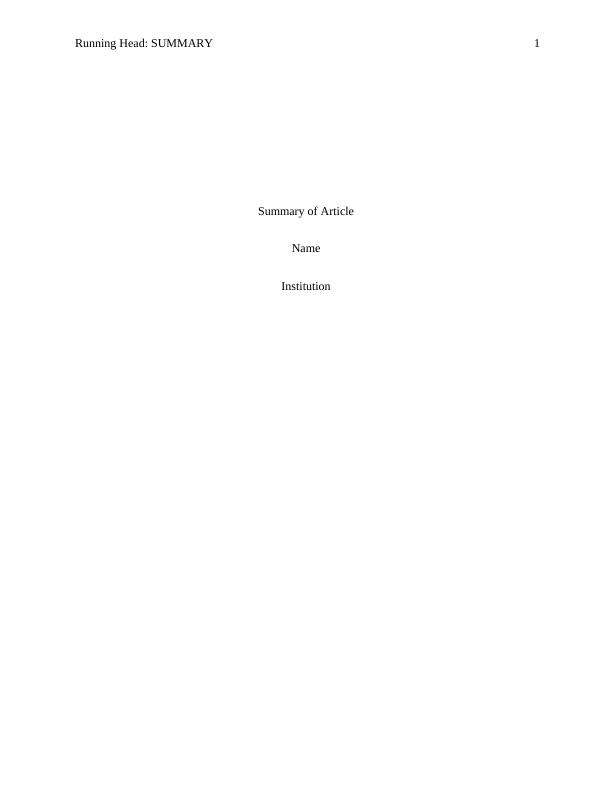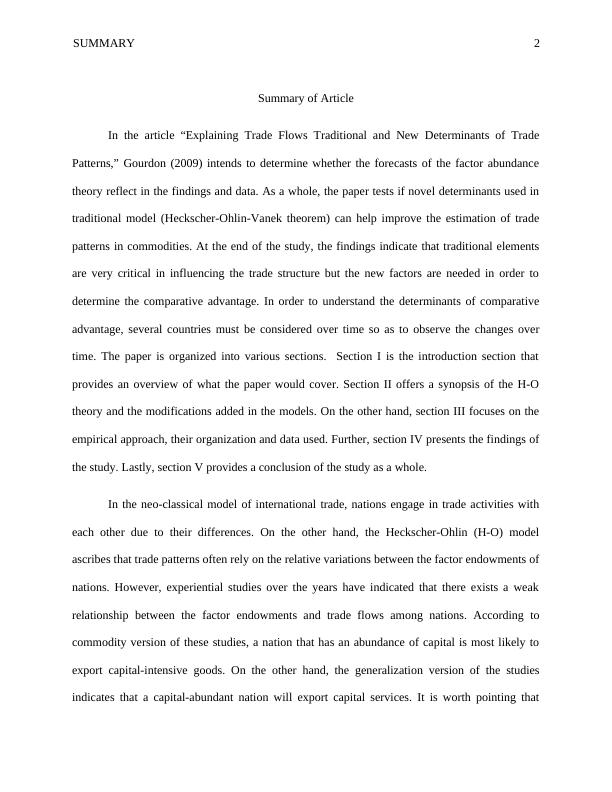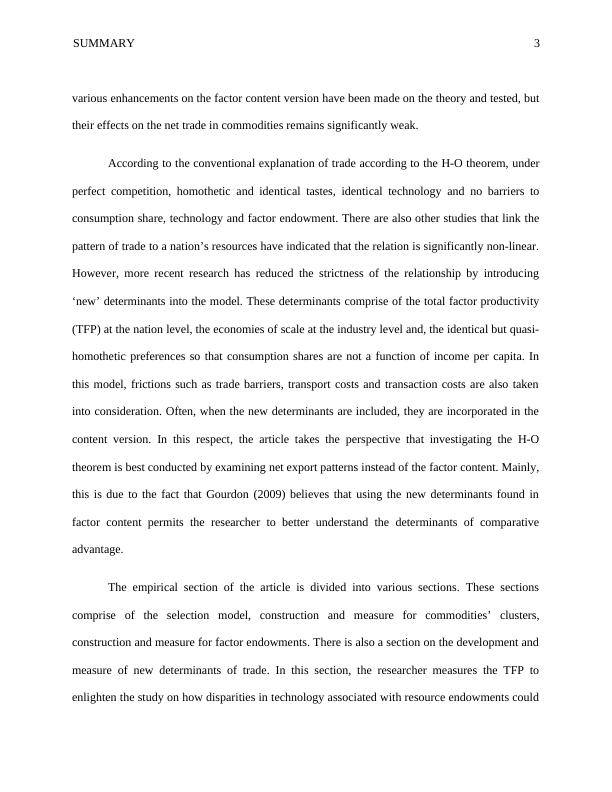Explaining Trade Flows: Traditional and New Determinants of Trade Patterns
Added on 2023-06-11
6 Pages1069 Words360 Views
Running Head: SUMMARY 1
Summary of Article
Name
Institution
Summary of Article
Name
Institution

SUMMARY 2
Summary of Article
In the article “Explaining Trade Flows Traditional and New Determinants of Trade
Patterns,” Gourdon (2009) intends to determine whether the forecasts of the factor abundance
theory reflect in the findings and data. As a whole, the paper tests if novel determinants used in
traditional model (Heckscher-Ohlin-Vanek theorem) can help improve the estimation of trade
patterns in commodities. At the end of the study, the findings indicate that traditional elements
are very critical in influencing the trade structure but the new factors are needed in order to
determine the comparative advantage. In order to understand the determinants of comparative
advantage, several countries must be considered over time so as to observe the changes over
time. The paper is organized into various sections. Section I is the introduction section that
provides an overview of what the paper would cover. Section II offers a synopsis of the H-O
theory and the modifications added in the models. On the other hand, section III focuses on the
empirical approach, their organization and data used. Further, section IV presents the findings of
the study. Lastly, section V provides a conclusion of the study as a whole.
In the neo-classical model of international trade, nations engage in trade activities with
each other due to their differences. On the other hand, the Heckscher-Ohlin (H-O) model
ascribes that trade patterns often rely on the relative variations between the factor endowments of
nations. However, experiential studies over the years have indicated that there exists a weak
relationship between the factor endowments and trade flows among nations. According to
commodity version of these studies, a nation that has an abundance of capital is most likely to
export capital-intensive goods. On the other hand, the generalization version of the studies
indicates that a capital-abundant nation will export capital services. It is worth pointing that
Summary of Article
In the article “Explaining Trade Flows Traditional and New Determinants of Trade
Patterns,” Gourdon (2009) intends to determine whether the forecasts of the factor abundance
theory reflect in the findings and data. As a whole, the paper tests if novel determinants used in
traditional model (Heckscher-Ohlin-Vanek theorem) can help improve the estimation of trade
patterns in commodities. At the end of the study, the findings indicate that traditional elements
are very critical in influencing the trade structure but the new factors are needed in order to
determine the comparative advantage. In order to understand the determinants of comparative
advantage, several countries must be considered over time so as to observe the changes over
time. The paper is organized into various sections. Section I is the introduction section that
provides an overview of what the paper would cover. Section II offers a synopsis of the H-O
theory and the modifications added in the models. On the other hand, section III focuses on the
empirical approach, their organization and data used. Further, section IV presents the findings of
the study. Lastly, section V provides a conclusion of the study as a whole.
In the neo-classical model of international trade, nations engage in trade activities with
each other due to their differences. On the other hand, the Heckscher-Ohlin (H-O) model
ascribes that trade patterns often rely on the relative variations between the factor endowments of
nations. However, experiential studies over the years have indicated that there exists a weak
relationship between the factor endowments and trade flows among nations. According to
commodity version of these studies, a nation that has an abundance of capital is most likely to
export capital-intensive goods. On the other hand, the generalization version of the studies
indicates that a capital-abundant nation will export capital services. It is worth pointing that

SUMMARY 3
various enhancements on the factor content version have been made on the theory and tested, but
their effects on the net trade in commodities remains significantly weak.
According to the conventional explanation of trade according to the H-O theorem, under
perfect competition, homothetic and identical tastes, identical technology and no barriers to
consumption share, technology and factor endowment. There are also other studies that link the
pattern of trade to a nation’s resources have indicated that the relation is significantly non-linear.
However, more recent research has reduced the strictness of the relationship by introducing
‘new’ determinants into the model. These determinants comprise of the total factor productivity
(TFP) at the nation level, the economies of scale at the industry level and, the identical but quasi-
homothetic preferences so that consumption shares are not a function of income per capita. In
this model, frictions such as trade barriers, transport costs and transaction costs are also taken
into consideration. Often, when the new determinants are included, they are incorporated in the
content version. In this respect, the article takes the perspective that investigating the H-O
theorem is best conducted by examining net export patterns instead of the factor content. Mainly,
this is due to the fact that Gourdon (2009) believes that using the new determinants found in
factor content permits the researcher to better understand the determinants of comparative
advantage.
The empirical section of the article is divided into various sections. These sections
comprise of the selection model, construction and measure for commodities’ clusters,
construction and measure for factor endowments. There is also a section on the development and
measure of new determinants of trade. In this section, the researcher measures the TFP to
enlighten the study on how disparities in technology associated with resource endowments could
various enhancements on the factor content version have been made on the theory and tested, but
their effects on the net trade in commodities remains significantly weak.
According to the conventional explanation of trade according to the H-O theorem, under
perfect competition, homothetic and identical tastes, identical technology and no barriers to
consumption share, technology and factor endowment. There are also other studies that link the
pattern of trade to a nation’s resources have indicated that the relation is significantly non-linear.
However, more recent research has reduced the strictness of the relationship by introducing
‘new’ determinants into the model. These determinants comprise of the total factor productivity
(TFP) at the nation level, the economies of scale at the industry level and, the identical but quasi-
homothetic preferences so that consumption shares are not a function of income per capita. In
this model, frictions such as trade barriers, transport costs and transaction costs are also taken
into consideration. Often, when the new determinants are included, they are incorporated in the
content version. In this respect, the article takes the perspective that investigating the H-O
theorem is best conducted by examining net export patterns instead of the factor content. Mainly,
this is due to the fact that Gourdon (2009) believes that using the new determinants found in
factor content permits the researcher to better understand the determinants of comparative
advantage.
The empirical section of the article is divided into various sections. These sections
comprise of the selection model, construction and measure for commodities’ clusters,
construction and measure for factor endowments. There is also a section on the development and
measure of new determinants of trade. In this section, the researcher measures the TFP to
enlighten the study on how disparities in technology associated with resource endowments could

End of preview
Want to access all the pages? Upload your documents or become a member.
Related Documents
International Trade and Enterpriselg...
|11
|3876
|83
International Trade and Enterpriselg...
|13
|3872
|34